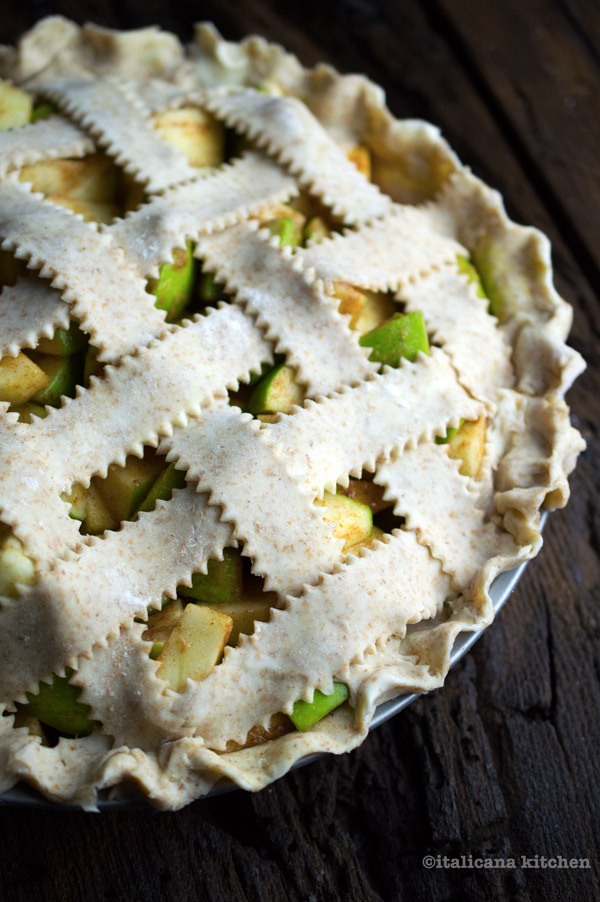This is a classic American apple pie recipe; well, kind of. In most traditional apple pie recipes you’ll find white sugar, white flour and thinly sliced apples :: mele. But, what kind of pie do you get when you use light cane sugar, a mix of whole wheat and all purpose flours, and chunk the apples? This is what I wanted to find out.
 Apple slices or chunks. Does it really make that big of a difference? I mean, come on, we’re still using apples, right? Yet, just think for a moment about eggs and all the different way eggs :: uova taste based on whether you scramble them, poach them whole or fry them over easy. The way the eggs are prepared changes the final outcome of the dish, same goes for how you cut your apples.
Apple slices or chunks. Does it really make that big of a difference? I mean, come on, we’re still using apples, right? Yet, just think for a moment about eggs and all the different way eggs :: uova taste based on whether you scramble them, poach them whole or fry them over easy. The way the eggs are prepared changes the final outcome of the dish, same goes for how you cut your apples.
 There are pros and cons to both methods. If you decide to go the thin crescent shaped route, the texture of the apples will be softer, the pie is easier to slice and serve and the apples stay orderly on the bottom crust like a well behaved dog lying on the front door mat. The downside is that sometimes the baked apple slices border on the verge of being mushy and release too much liquid in the pie, resulting in a soggy crust. For a filling that is all about the fruit, then generous chunks of apples are the perfect solution. The apple hunks remain quite firm in between the cooked crusts so you really have a bite to your pie and you taste a stronger off-the-tree-apple-flavor. I took my experimenting to another level, and left the skins on for color and crunch. My suggestion to you though would be to peel the skins because the disadvantage to this technique is that the skins prevent the apple chunks from molding together and they misbehave like hyperactive toddlers and have troubles staying in the crust when served on a plate. If you peel them, they mold together better when baked. In any case, these chunks sweetened with cane sugar and spiced with cinnamon :: cannella, nutmeg and ginger don’t remain for long as vagabonds on the plate.
There are pros and cons to both methods. If you decide to go the thin crescent shaped route, the texture of the apples will be softer, the pie is easier to slice and serve and the apples stay orderly on the bottom crust like a well behaved dog lying on the front door mat. The downside is that sometimes the baked apple slices border on the verge of being mushy and release too much liquid in the pie, resulting in a soggy crust. For a filling that is all about the fruit, then generous chunks of apples are the perfect solution. The apple hunks remain quite firm in between the cooked crusts so you really have a bite to your pie and you taste a stronger off-the-tree-apple-flavor. I took my experimenting to another level, and left the skins on for color and crunch. My suggestion to you though would be to peel the skins because the disadvantage to this technique is that the skins prevent the apple chunks from molding together and they misbehave like hyperactive toddlers and have troubles staying in the crust when served on a plate. If you peel them, they mold together better when baked. In any case, these chunks sweetened with cane sugar and spiced with cinnamon :: cannella, nutmeg and ginger don’t remain for long as vagabonds on the plate.
 Whether you chunk your apples or thinly slice them comes down to personal preference. One thing is certain, both methods are delicious. And, if you really can’t decide then just make the pie :: torta more than once to know which style you like more. Which in my book is not such a bad thing since it means you get to eat more apple pie. For “research” of course. 🙂
Whether you chunk your apples or thinly slice them comes down to personal preference. One thing is certain, both methods are delicious. And, if you really can’t decide then just make the pie :: torta more than once to know which style you like more. Which in my book is not such a bad thing since it means you get to eat more apple pie. For “research” of course. 🙂
- For the double pie crust:
- 16 tbsp. (225g) unsalted butter
- 1½ cups (170g) whole wheat flour
- 1 cup (145g) all purpose flour
- 2 tbsps (26g) cane sugar
- ½ tsp. (3g) salt
- 4-6 tbsp. ice water
- For the filling:
- 3½ lbs (about 1.6 kg) apples (I used Granny Smith)
- 7 medium granny smith apples (about 3½ pounds)
- 2 tablespoons freshly squeezed lemon juice (1 small lemon)
- ½ cup (90g) cane sugar
- 2 (20g) tablespoons whole wheat flour
- 2-3 pinches sea salt
- ½ teaspoon of ground or grated nutmeg
- 1 teaspoon ground cinnamon
- ¼ teaspoon ground ginger
- 1 egg, lightly beaten
- For the pie crust:
- Cut the butter into small pieces, stick them on a plate and pop it into the freezer for five minutes.
- Put the flours, light brown sugar and salt in the bowl of a stand mixer and mix with the paddle attachment until blended. On low speed, add the pieces of butter and gradually increase the speed to medium-low. When the butter chunks are the size of peas, reduce the speed to low and add the water one tablespoon at a time, just until the dough comes together. Remove the dough, divide it into two equal pieces, press into disks, wrap with plastic wrap and pop them in the refrigerator for at least half and hour (or up to 2 days). You can also freeze this dough for up to 1-2 months, just let it thaw out for a day in the refrigerator before use.
- For the filling:
- Peel, core and cut the apples into chunks, tidbits or thin slices. Place in a large bowl and toss with lemon juice, sugar, whole wheat flour, salt, nutmeg, cinnamon and ginger. Stir until combined.
- For the oven: Preheat to 425°F.
- To assemble the pie:
- Flour a large work station. Take out one of the pie disks and lay it on your now well floured table. Flour the top of the disk as well as the rolling pin and roll it out until it’s about 12-inches. Roll the dough onto the rolling pin and gently lay it over a 9-inch pie plate so that there is some overhang. Add the fruit mixture and juices to the bottom pie crust.
- Flour your workstation again, then roll out the second disk to a 12-inch round.
- For a lattice-top: Use a pastry wheel, pizza cutter or knife to cut the rolled out pie crust in 1-inch strips. Then weave together the lattice strips to form a lattice top. Trim off excess dough and crimp the edges together. I hope to make my own video soon, but in the meantime you can watch this quick video to see how it’s done. https://www.youtube.com/watch?v=8i3oQT-aaG0
- For a regular lidded top: simply roll up the dough onto the rolling pin and set it over the pie plate. Crimp the edges together and cut a few slits in the center so the pie can vent when cooking. You can also use cookie cutters to cut a decorative vent before you sent the crust on top of the pie plate. I hope to make my own video soon, but in the meantime you can watch this quick video to see how it’s done. https://www.youtube.com/watch?v=sAkCbXXIht4
- For the finishing touches: Brush the top of the pie with the beaten egg. Sprinkle the top of the pie with light cane sugar.
- Baking: Bake for 15 minutes then reduce the oven temperature to 350°F. Continue to bake for another 35-40 minutes or until the crust is golden brown. (Check on the pie a few times. If it is browning too quickly, tent loosely with foil and continue baking as indicated above.)
- Cooling: Although it will be torturous to wait, let the apple pie cool 2-3 hours before serving so that the juices will have thickened up. Store the pie at room temperature or in the fridge. Slice and serve with whipped cream or big scoop of vanilla ice cream.
